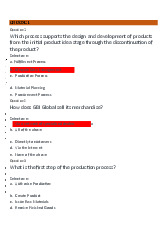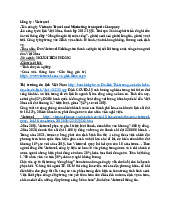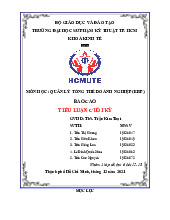


















Preview text:
2020 Top 10 Public Sector ERP Systems Report lOMoAR cPSD| 58797173 ©Copyri ght 2019 ,
©Copyright 2019 , Panorama Consulting Grou p . Panorama Consulting Grou Do p . wn lAll Rights Reserved. o A ll Rights Reserved. lOMoAR cPSD| 58797173 Introduction
Panorama Consulting Group developed the 2020 Top 10 Public Sector ERP Systems Report to provide ERP
selection guidance to states, cities, agencies and tribal governments.
The analysis is based on past client experience, vendor RFI and RFP responses we’ve received, as well as
data from reliable industry sources. We’ve managed the demonstration process for numerous clients,
giving us direct exposure to the applications and development teams behind them.
States, cities and municipalities are facing many challenges, including an aging workforce, an increasing
demand for transparency, a growing population of citizens to serve and finally, employee (and citizen)
resistance to changing processes and technology: Aging Workforce
The mass retirement of the Baby Boomer generation will leave public sector organizations with the
challenge of retaining the knowledge of experienced employees. This knowledge loss can have a huge
impact on budget consumption when meeting the needs of a growing constituent base.
Demand for Transparency
Another major issue is the increasing pressure to be transparent and demonstrate the value of ERP
investments. This value may be intangible if the agency has not established the right performance measures. Growing Population
Overall, there has been exponential growth in the population that U.S. states, cities and municipalities
serve. If this applies to you, it’s important not to adhere to archaic processes as this will hinder your ability
to meet the demands of constituents.
Even if the population you serve has decreased, modernizing your systems is still essential despite financial limitations. lOMoAR cPSD| 58797173 Change Resistance
Economic globalization offers opportunities to improve living conditions for citizens across the globe. This
requires that the public sector substantially transform and restructure to meet social demands.
As such, the most urgent challenge for states, cities and municipalities is to help their citizens and
employees adopt processes that promote a sustainable economic and social environment.
If population and economic growth is dynamic with increasing demands both from population increases
and GDP growth, the pressure on government to satisfy unmet social needs will become burdensome
unless government adapts mentally and structurally.
Panorama has witnessed these issues as we help states, cities, agencies and tribal governments improve
business performance and customer service. Our clients have overcome these challenges by improving
internal communications, creating shared domain knowledge, improving business processes and redefining
the relationship between business and IT executives. With these improvements comes the ability to
successfully evaluate technology options and realize more value from ERP investments.
The vendors featured in this report were chosen based on the strength of their public sector functionality
as well as the amount of research and development invested in these products. The order is not based on ranking but on vendor size: • SAP Public Sector • Oracle Public Sector • Infor Public Sector • Tyler Technologies • Microsoft 365 Government • Deltek • Unit4 • Harris Computer Systems • BS&A Software
• Central Square Technologies lOMoAR cPSD| 58797173
What Digital Transformation Looks Like in the Public Sector
Improving the customer (citizen) experience is the primary aim of digital transformation initiatives in the
public sector. Once processes are designed for an optimal customer experience, public sector organizations
must focus on transitioning employees. This requires a strong focus on change management.
Change management not only enables organizations to adapt to new processes, but it enables them to
change their organizational culture to support the deployment of a digital strategy.
A key success factor of digital transformation for Case Study
the public sector is the ability to become a digital
A large capital city in the United States
government by selecting the right technology. To
engaged Panorama to determine the
prepare for technology selection, organizations
effectiveness of the change management
must focus on business process management and
component of their ERP project. Our
reengineering. This enables them to define the daily
consultants reviewed the city’s change
management strategy, plans, tools and
activities that deliver customer value. Only with the
related documentation. We then
clear definition of current and future state provided recommendations for
processes, can organizations select the right
improvement allowing the city to move technology. forward and regain momentum.
With the help of the right ERP systems, predictive analytic tools and business intelligence tools,
organizations can gain valuable insights into their data. They also find opportunities to leverage data to enable automation.
We have found that public sector organizations are increasingly relying on artificial intelligence to augment
their data insights. Our client engagements often focus on improving access to real - time data to enable
accurate predictions about future needs. Clients realize efficiency gains from the ability to predict customer
behavior and the ability to use their people, process and technology to quickly meet the needs of constituents. lOMoAR cPSD| 58797173
ERP Functionality for States, Cities & Municipalities
Following is a list of functional areas that states, cities and municipalities often look for within enterprise systems:
• Public Services (Utilities and • Schools Engineering) • Public Safety • Tribal Management • Buildings • Special Districts
• Planning & Economic Development
• Procurement & Contracts • Clerk's Office
• Financial & Accounting • Community Services • HR & Payroll • Parks & Recreation
In our experience, many organizations implement functionality in phases as opposed to all at once. This
makes the implementation more manageable and can reduce the risk of a significant operational disruption.
Below is an example of how an organization might integrate their systems in phases:
Continued on followin g page . . . lOMoAR cPSD| 58797173
In phases three and four, all applications are integrated into one end - to - end solution.
Integrated systems result in many business benefits, including the elimination of
organizational silos and increased reliability of data. lOMoAR cPSD| 58797173
Top 10 Public Sector ERP Vendors & Niche Applications SAP Public Sector
SAP is designed for large, enterprise type organizations across the globe. While the solution
set can be the longest in duration to implement, it is often built specifically for the organization’s needs. Strengths:
• Strong focus on technology development and user experience • Machine learning
• Analytics and data modeling • End - to - end platform lOMoAR cPSD| 58797173 Oracle Public Sector
Oracle also has made its mark on a global scale. The platform is a complex set of applications
that can be leveraged in basic and advanced ways. Larger organizations are able to leverage
more out - of - the - box configurations. Strengths: • Technology and mobility • In - depth functionality
• Best practice implementation accelerators • Data analytics lOMoAR cPSD| 58797173 Infor Public Sector
Infor is still emerging as a global, enterprise solution. The platform is a set of applications that
can be configured to meet organizations’ needs. Many large enterprise type organizations are
matching up well with best practice implementation accelerators. Strengths:
• User experience and enhancement capabilities
• Business intelligence and data analytics
• Strong focus on industry verticals
• Workflow and repeatable process automation lOMoAR cPSD| 58797173 Tyler Technologies
As a leading mid - market offering, Tyler Technologies focuses only on public sector software
applications and has captured a good amount of the market share. Typically, most of its
applications are a good fit for mid - sized entities out - of - the - box with many easily adopted best practices. Strengths:
• Niche applications built for the public sector
• Numerous pre - defined, out - of - the - box processes • Rapid deployments
• Strong industry experience lOMoAR cPSD| 58797173
Microsoft 365 Government
This platform is a strong offering for small to mid - sized organizations. It is typically a good fit
for organizations that are already leveraging the Microsoft technology stack. Microsoft is
emerging and gaining market - share with many pre - configured processes. Strengths:
• User familiarity with Microsoft base applications
• Scalability from small to larger organizations
• Wide resource availability
• Configuration and enhancement capabilities lOMoAR cPSD| 58797173 Deltek
Deltek is a steady - paced vendor experiencing growth and cloud consolidation of their
products. This vendor offers a varied set of solutions for small to large organizations with
flexibility in their basic versus advanced functionality. Strengths:
• Functionality for simple and more complex organizations
• Merges best practices in all applications
• Focused industry expertise
• Experiencing organic growth by gaining market share via rich functionality lOMoAR cPSD| 58797173 Unit4
Unit4 is a quickly emerging North American vendor with a global footprint. This vendor has a
solid product offering for small to mid - sized organizations with many standard, out - of - the -
box processes that are pre - configured. Strengths: • Solid industry experience
• Best practice and standardized configurations • Focus on user experience
• Focus on strong client relationships lOMoAR cPSD| 58797173
Harris Computer Systems
Harris Computer Systems is an emerging vendor that has acquired a small handful of niche
applications in order to offer smaller to midsized organizations an end - to - end offering. Strengths: • Global footprint
• Industry experience with small - to mid - sized organizations
• Focus on a small handful of industry verticals
• Organic growth by acquisition lOMoAR cPSD| 58797173 BS&A Software
This is an emerging niche vendor that offers many edge products to extend their core
application and can also augment other core products. Strengths:
• Integration of solution sets • Microsoft technology
• Simple, standardized configurations
• Shorter implementation duration lOMoAR cPSD| 58797173
Central Square Technologies
This vendor is growing by acquisition and combining best practices of leading niche
applications to create an end - to - end solution. Strengths: • Broad industry experience
• Focus on small - to mid - sized organizations
• Workflow and automation capability
• Relatively simple configuration lOMoAR cPSD| 58797173
ERP Evaluation & Selection Advice
Many states, cities and municipalities are using old systems because their workforce doesn’t have the
skillset to use new technology. In some cases, organizations are using new technology but without integration.
For example, one client we worked with diagramed all of their systems and found they had about 200
systems, most of which did not integrate with each other. We found this was caused by organizational silos
and a failure to take a holistic view of how systems should operate.
When defining selection criteria, organizations should consider more than just their immediate needs. This
holistic view requires strong leadership from the top of the organization.
Unfortunately, the executive team doesn’t always have a clear, consistent vision. This is often due to the
high executive turnover rate, especially when it comes to elected officials.
While the lack of clear goals presents a challenge for public sector organizations beginning ERP selection, it
is not their only obstacle. Another obstacle they must overcome is a lack of funding.
Often, it is difficult for public sector organizations to get funding approval for an ERP project because the IT
budget is limited by competing requests across the municipality. Many government executives won’t
allocate money toward IT unless something is clearly broken.
Obtaining funding approval for an ERP project can be especially difficult because of the resource
requirements. ERP projects require extensive IT staffing and a variety of subject matter experts. Most public
sector organizations have limited internal resources to dedicate to an organization - wide project. lOMoAR cPSD| 58797173
The organizations that overcome these obstacles Case Study
face a new set of challenges during ERP selection.
One city we worked with had been on
One of the most daunting aspects of selection is
their existing ERP solution for several
determining which vendors offer what functionality.
decades, and it was not ideal for their
processes. It also had high maintenance
While large systems, like SAP and Oracle systems,
costs. We developed a strategic plan for
the city’s future state, created a
have public sector functionality, these systems are
business process map to pinpoint the
not specifically designed for the public sector. In
most critical functionalities and
contrast, niche systems, like Tyler Technologies, are
conducted a technical fit assessment to
specifically designed for the public sector and offer
find the best technology for their needs.
more robust functionality in many areas.
Another selection challenge is organizations’ lack of documented processes. This makes it difficult for
organizations to provide a complete list of business requirements to vendors.
In place of process documentation, public sector organizations tend to rely on “tribal knowledge” and
workarounds. If this sounds like your organization, it’s important to involve stakeholders in process mapping
sessions and mitigate resistance to change as early as possible.
One of the most prevalent problems we’ve seen in organizations’ selection process is a haphazard RFP
( request for proposal) process. Oftentimes, when public sector organizations issue their initial RFP, they ask
for vendors to respond instead of consultants. Essentially, they expect these RFP responses to define their
vendor shortlist, whether or not their RFP contains a complete list of business requirements.
However we’re seeing more organizations issue their initial RFPs for consultants instead of vendors. These
organizations are realizing the value of third
- party guidance when evaluating vendor RFP responses.
Consultant expertise not only helps organizations understand vendor functionality, but it minimizes the risk of vendor protests. lOMoAR cPSD| 58797173
Vendor protests occur when vendors that are not awarded your RFP protest the decision on the basis of
issues like favoritism. These protests can halt the RFP process as investigations ensue.
Organizations working with third - party consultants can avoid this headache. For example, independent ERP
consultants, like Panorama, advise clients to document as much as possible. This includes evaluation criteria,
RFP schedules, demo scripts, reference checks, committee meetings and more. Most of our clients don’t
have the experience or bandwidth to document everything necessary for discouraging vendors from protesting. lOMoAR cPSD| 58797173
The Importance of Strategic Alignment
While the implementation of new technology is a key way organizations improve their service to citizens,
we do not focus on technology at the beginning of our engagements.
Instead, we focus on strategic alignment. Once alignment is achieved, we can then gather ERP
requirements to help organizations understand what technology will enable them to meet their objectives.
Strategic management, planning and alignment are becoming much more important to the public sector.
By strategic alignment we mean the alignment of all stakeholders around project goals.
It is not always easy to think about strategic alignment in the public sector since the concepts of growth,
profit and competitive advantage tend to be foreign to public sector organizations. However, there is one
goal around which public sector organizations should align their operations: return on citizenship (ROC).
ROC can best be described as a measurement of success similar to return on investment. In essence, ROC is
the measurement of social value creation that provides citizens and their communities with the increased return.
Return on what? Return on income taxes, FICA, sales taxes and all sorts of local taxes that go to support all
public services. The return on this money is the benefits it provides citizens.




